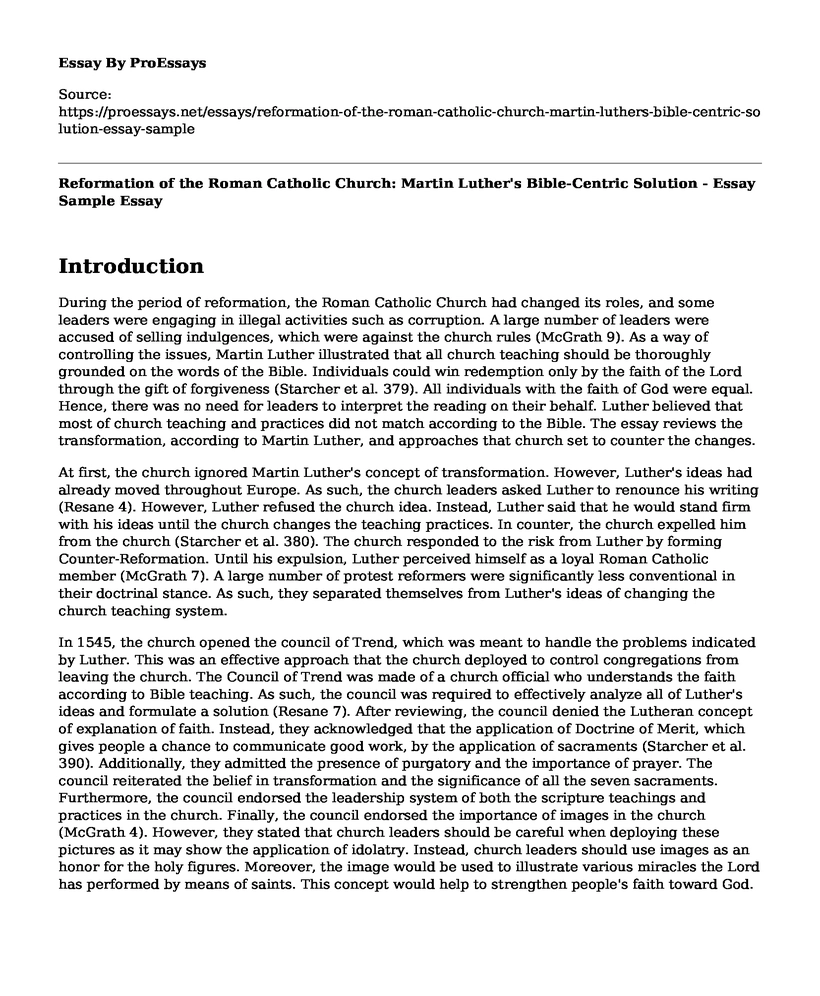Introduction
During the period of reformation, the Roman Catholic Church had changed its roles, and some leaders were engaging in illegal activities such as corruption. A large number of leaders were accused of selling indulgences, which were against the church rules (McGrath 9). As a way of controlling the issues, Martin Luther illustrated that all church teaching should be thoroughly grounded on the words of the Bible. Individuals could win redemption only by the faith of the Lord through the gift of forgiveness (Starcher et al. 379). All individuals with the faith of God were equal. Hence, there was no need for leaders to interpret the reading on their behalf. Luther believed that most of church teaching and practices did not match according to the Bible. The essay reviews the transformation, according to Martin Luther, and approaches that church set to counter the changes.
At first, the church ignored Martin Luther's concept of transformation. However, Luther's ideas had already moved throughout Europe. As such, the church leaders asked Luther to renounce his writing (Resane 4). However, Luther refused the church idea. Instead, Luther said that he would stand firm with his ideas until the church changes the teaching practices. In counter, the church expelled him from the church (Starcher et al. 380). The church responded to the risk from Luther by forming Counter-Reformation. Until his expulsion, Luther perceived himself as a loyal Roman Catholic member (McGrath 7). A large number of protest reformers were significantly less conventional in their doctrinal stance. As such, they separated themselves from Luther's ideas of changing the church teaching system.
In 1545, the church opened the council of Trend, which was meant to handle the problems indicated by Luther. This was an effective approach that the church deployed to control congregations from leaving the church. The Council of Trend was made of a church official who understands the faith according to Bible teaching. As such, the council was required to effectively analyze all of Luther's ideas and formulate a solution (Resane 7). After reviewing, the council denied the Lutheran concept of explanation of faith. Instead, they acknowledged that the application of Doctrine of Merit, which gives people a chance to communicate good work, by the application of sacraments (Starcher et al. 390). Additionally, they admitted the presence of purgatory and the importance of prayer. The council reiterated the belief in transformation and the significance of all the seven sacraments. Furthermore, the council endorsed the leadership system of both the scripture teachings and practices in the church. Finally, the council endorsed the importance of images in the church (McGrath 4). However, they stated that church leaders should be careful when deploying these pictures as it may show the application of idolatry. Instead, church leaders should use images as an honor for the holy figures. Moreover, the image would be used to illustrate various miracles the Lord has performed by means of saints. This concept would help to strengthen people's faith toward God.
Conclusion
In conclusion, leaders in the Roman Catholic Church were engaging in corruption, which diverted the teaching and practices. As a way of controlling the issues, Martin Luther illustrated that all church teaching should be fully grounded on the words of the Bible. However, the church formed Counter-Reformation by first expelling Luther. Additionally, the church formed the council to review the issue and develop a long-lasting solution.
Works Cited
McGrath, Alister E. "Martin Luther in Dialectical Theology." Oxford Research Encyclopedia of Religion. 2016. https://ora.ox.ac.uk/objects/uuid:0d4f3ae5-27d8-4c13-9396-a34ccb3e0cdd/download_file?file_format=pdf&safe_filename=acrefore-9780199340378-e-300.pdf&type_of_work=Book+section. Accessed on 7th Dec. 2019.
Resane, Kelebogile T. "Miracles in the Neo-Charismatic Movement: Historical and Theological Critique." Verbum et Ecclesia 38.1 (2017): 1-8. http://www.scielo.org.za/scielo.php?pid=S2074-77052017000100028&script=sci_arttext&tlng=es. Accessed on 7th Dec. 2019.
Starcher, Richard L., et al. "Perspectives on the Missiological Legacy of Martin Luther and the Protestant Reformation." Missiology 45.4 (2017): 374-395. https://journals.sagepub.com/doi/pdf/10.1177/0091829617731594?casa_token=jfBiRtP_7bEAAAAA:VH0nyK-iuucM153vGFiYM9xD3Blyb8-nEbQNhleOP4i8Qzf7TQjaDCZVQC5DFwoTXf0hLFqVC6sC0g. Accessed on 7th Dec. 2019.
Cite this page
Reformation of the Roman Catholic Church: Martin Luther's Bible-Centric Solution - Essay Sample. (2023, Mar 14). Retrieved from https://proessays.net/essays/reformation-of-the-roman-catholic-church-martin-luthers-bible-centric-solution-essay-sample
If you are the original author of this essay and no longer wish to have it published on the ProEssays website, please click below to request its removal:
- Impacts of First and Second World War to the America Society Essay
- Essay Example on Abina's Unfair Trial: Injustice of Slavery in the British Colony
- Essay Sample on Soviet Union's Rise: Stalin's Totalitarian Policies & WW2 Impact
- Great Rebellion: The American Civil War & Its Causes - Essay Sample
- Essay Example on Friedrich Nietzsche: Radical Aristocrat, Poet & Prophet
- Paper Sample on Lost World: The Native Americans' Reverence for Earth and Life
- Essay Sample on African-Americans: Cast Down Your Bucket Where You Are







